adriaticnature starts a section handmade with a conversation with the master of “metal jig construction” from the Russian city of Yevpatoria, Sergey Rostetskiy. Sergey is known probably not only to anglers of the Black Sea coast, but also to many anglers interested in sea predator fishing, thanks to his excellent jigs, which he has been making for a long time, gradually supplementing and expanding their model range. Constant tests of bait in the real conditions of the Black Sea, enable Sergey to check, improve the models and make sure that they have great “catching” properties. Sergey answers the questions of readers and subscribers of his personal Facebook page with great pleasure, doesn’t conceal the secrets of choosing bait, and shares all the useful information related to helping readers in their future fishing sea adventures. Predatory fishes of the Adriatic Sea will love Sergey Rostetskiy’s jigs without any doubt.

(Sergey Rostetskiy. Author’s photo).
– Sergey, hello! Thank you for agreeing to talk about your bait on the pages of adriaticnature. We are sure that your experiments with sea jigs on the Black Sea and a thoughtful approach to their production, which made you the expert, will make all the readers reflect on this topic. To begin with, tell me, please, how did you end up like this? How did you start making metal jigs?
– I didn’t have enough money for bait-). And this is the truth.
– Have you done anything by hand before?
– Yes, I’ve always done a lot by hand.
– And why did you choose jigs? Is it because they appeared to be the most attractive bait for fish from that you came across before? Why not silicone lures or plugs, for example?
– I started with making silicone lures or plugs-).
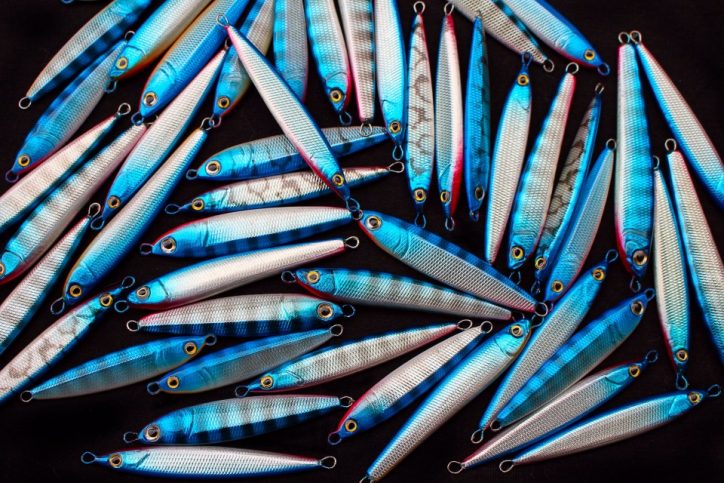
(Sergey Rostetskiy’s handmade jigs. Photo by © Sergey Rostetskiy)
– adriaticnature saw on facebook that you got interested in “jig construction” after you tried the jig After Burner Mini made by the Japanese company Xesta.
– Yes. And also the jig produced by the Japanese company Shout! Jig Dangan.
– Did these baits surprise you by the number of bites? Compared to plugs and silicone lures?
– I was surprised by the “quality” of bites. “Metal” makes bites more vicious.
– And, as far as I understand, you started making copies of these models for yourself, until you came up with your own, didn’t you?
– In general, yes. And also there were a lot of different experiments with nails, skewers, and other pieces of metal.
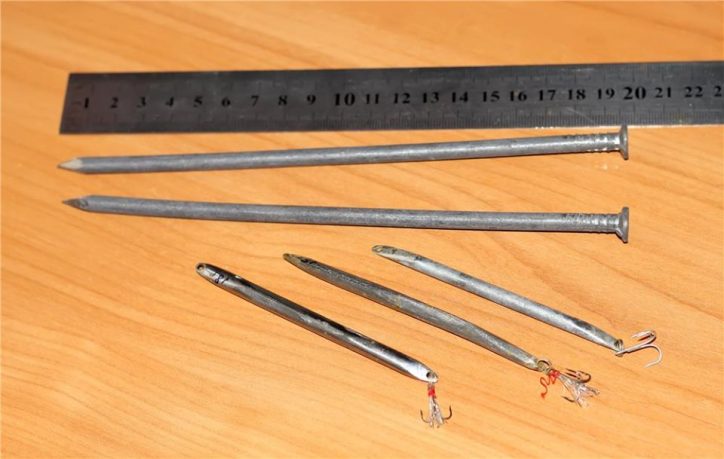
(Handcrafted items made from nails. Photo by © Sergey Rostetskiy)
– And how did the nails with skewers come out?
– Both nails and skewers work. Nails were good for catching garfish, I didn’t try them with horse mackerel in particular, it wasn’t its season, and then it wasn’t the nails season. The skewer pieces are good bait too. And you don’t even have to bend them, they already play well even being straight.
– Yeah, that’s funny.
– I had only one funny case with a nail – the first fishing. At first friends laughed at me, and then they stopped laughing for some reason-). After I caught a couple of garfish-).
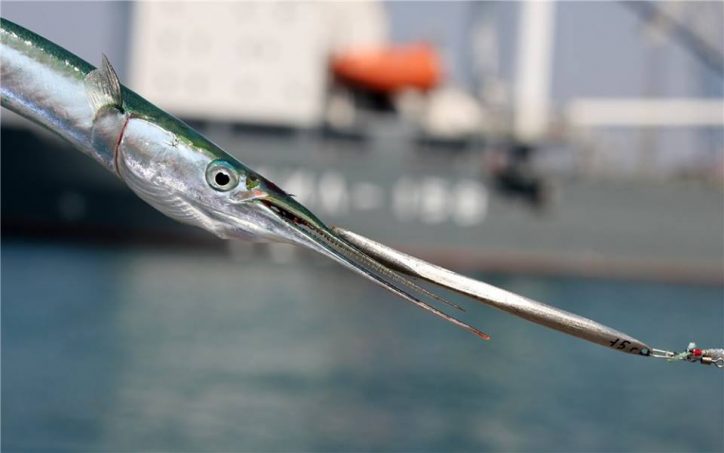
(The nail in action. Photo by © Sergey Rostetskiy)
– On forms. What are the basic criteria for creating them? What performance characteristics should a jig have to make fish interested?
– Well, first of all, it should somehow remind food. Secondly, it depends on the fish I want to make it for. Garfish, for example, often likes accelerated following. So a wide bait won’t work, it will jump out of the water at high speeds. When you need, on the contrary, a slower following with a beautiful “falling” on pauses, then the bait should be wider, with a bulging side or edges along the sides. Different followings require different forms.

(“Stavridka” (“Horse mackerel”) jig in action. Photo by © Sergey Rostetskiy)
– Is it important for the bait to resemble a habitual object of hunting to the predator in color? If you look at the color palettes presented in the market in Japan, you can be surprised by the infinite number of their options.
– I noticed only one regularity. On those days, when fish bites badly naturally colored baits, “acid” ones are usually in favor. And, accordingly, on the contrary. That is, “acid” isn’t taken, when natural colors are preferred. I have no idea why it is so. But the transparency of the water, the lighting, the time of the day – they just don’t influence at all. I can’t explain this, just an observation. Everyone can experiment and draw conclusions. Maybe even the opposite ones.
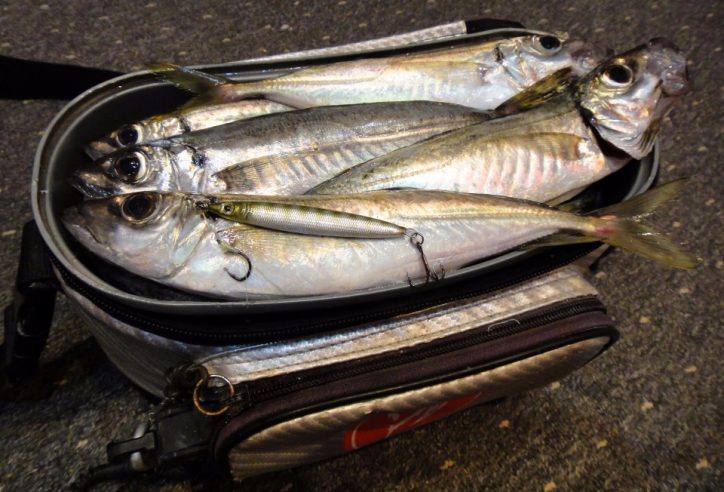
(“Skumbrija” (“Mackerel”) jig and take. Photo by © Sergey Rostetskiy)
– An interesting observation. And in your opinion, is the correct choice of bait weight important? Were there situations when you picked up the color correctly, and fish refused to eat, say, 12 gram bait? But the 15 gram bait was perfect.
– Very often. Bluefish was a vivid example. I had the same baits of 12, 15 and 18 grams. They were painted the same way, the shape was the same. Only the weight was different. The depth of the catch was up to 4 meters. So, bluefish didn’t respond to bait weighing 12 grams at all. 15 grams were not bad. But on 18 grams were perfect. And the fish was in the everywhere in water and not far from the berth, it means that all the baits reached the fish. But here the heavier and the larger ones had the best result. There is often a similar situation horse mackerel and garfish, especially garfish. It doesn’t want 15 grams, but it is actively caught with 35. Again, all the jigs get to the fish, but the heavier ones move faster, and this turns the fish on.
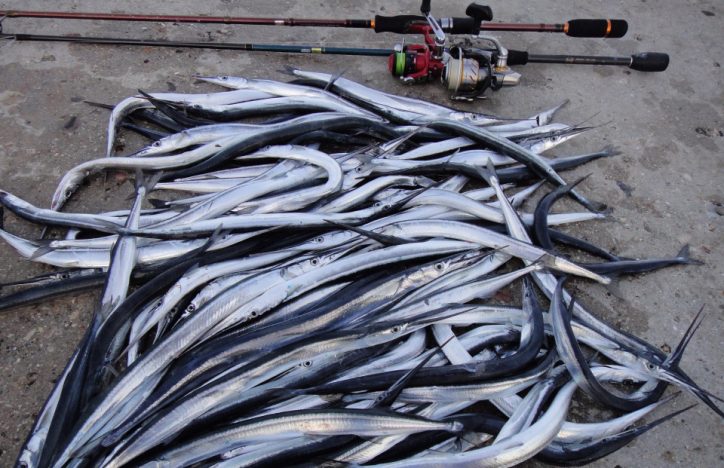
(“Tjuljka” (“Sprat”) jig – garfish killer. Photo by © Sergey Rostetskiy)
– How often do you use hooks when fishing with jigs? Under what circumstances do you put them or don’t put them?
– I put them almost always. But there is one catch. If out of 10 caught fish the hook was grabbed just by one, two fish, or even none, I take it off. It happens, when the horse mackerel doesn’t want to take the bait with the hook at all, as soon as you take it off – the bite gets better. It happens vice versa, 90% of the fish bites the hook. Then I remove the treble and catch fish with pleasure, without any overlaps, with the wildest followings. But this happens much less often.
– What is the producer of trebles and hooks you use for jigs?
– It can be any producer. They have to be sharp. That’s it. I usually choose single hooks that are made of thick wire. Even the ones for carp fit.

(“Stavridka” (“Horse mackerel”) jig and horse mackerel. Photo by © Sergey Rostetskiy)
– In your opinion, what should be the characteristics of a set of a spinner, who decided that your jigs should be in his box?
– Well, there have to be boxes for baits, and that’s the main thing! Nothing else matters.
– So, in your opinion, you can start catching fish with jigs using the available gear, right?
– In most cases, it is not possible, but necessary. There is a chance that you won’t like the process. Why should you waste your money then? I like slow sticks, but this is my personal view of spinning rods. Yes, and fast sticks “lose” horse mackerel. Everyone should decide what he likes. Braid PE #0.6-0.8, fluorocarbon shock leader 0.2-0.26 mm – this is for our small stuff. Horse mackerel, garfish and so on.
– Nowadays you make 6 models of jigs: “Skumbrija” (“Mackerel”), “Hamsa” (“European anchovy”), “Tjuljka” (“Sprat”), “Anchous” (“Anchovy”), “Stavridka” (“Horse mackerel”) and “Daljnobojka” (“Long ranger”). Am I right?
– Yes. The rest are rejected for technical reasons.
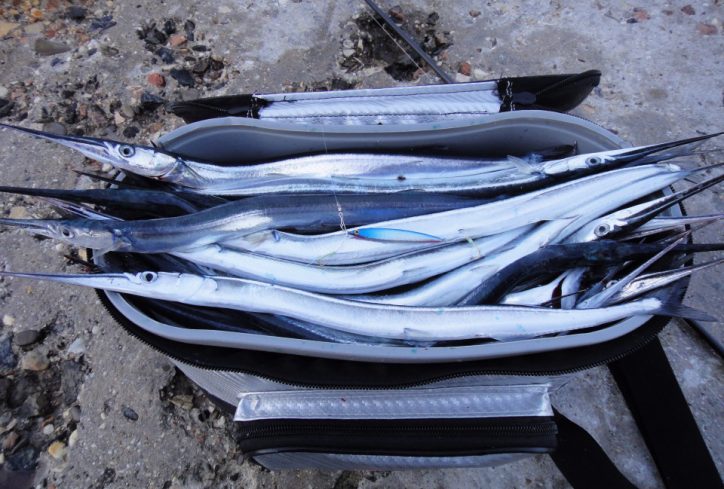
(“Tjuljka” (“Sprat”) jig and garfish. Photo by © Sergey Rostetskiy)
– So you plan to expand the range, don’t you?
– Of course, I do. Now I am trying to make a new model, but the master who makes the forms by my order is busy. I’ll have to wait. There will be a copy of seabream, a small one, if it will be. “Seabream” is almost ready, I should make eye sockets. And it’s done. But this is where I got stuck. Because at first I need to know the weight of the bait at the planned size, and the master has not calculated it yet. If I’ll have to make the model smaller, the eyes will decrease, and it’s no good at all. To put the matter in a nutshell, everything is done slowly, and I want it to be done yesterday!-)
– Say a couple of words concerning the following of jigs? Are there any tricks?
– It is advisable to change the position of the tip of the spinning rod (sharply and crucially) while following. That is, if you are twitching sideways, for example, or down, it doesn’t matter, and then sharply raise the spinning rod up and do two or three jerks with pauses. After that you lead the bait, as in the beginning of the following. And you make such changes of the game several times on the same cast. The bite improves a lot, almost always! Bites occur mainly at the time of a sudden change in the direction of the bait.
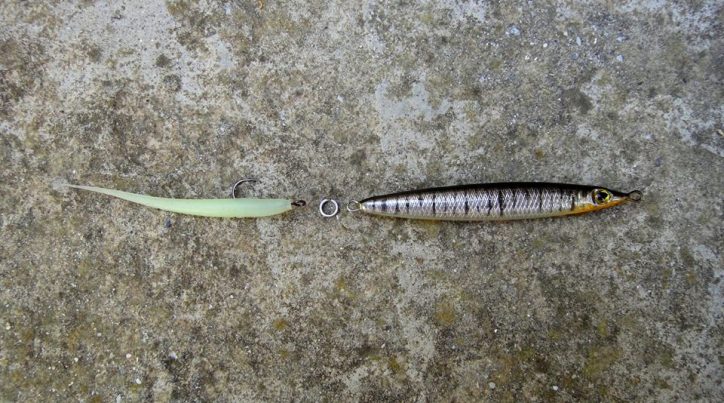
(Combination jig + silicone lure. Photo by © Sergey Rostetskiy)
– What do you think about the combination of a jig and silicone lure?
– This issue has been one of the most frequent topics for internet battles lately. Usually there are arguments about the “jig plus silicone is not aesthetically pleasing”, because the jig in this case simply serves as a plummet. My opinion is as follows – it’s true in most cases. It is very easy to check this in the process of fishing. For example, the following situation: the horse mackerel bites at the jig, equipped behind a single hook with silicone lure attached to it. It’s really easy to understand what exactly gives a good result. You just have to remove the silicone and continue to catch fish with the jig. If the bite is the same – then why using the bait with “silicone”? If it doesn’t bite, mount the silicone lure on a jig-head. Cast it again. It bites. We come to the conclusion that in this situation the jig works as an ordinary sinker. It may happen that using the same fairly heavy plummet, for example, weighing 8 grams, the bite will get worse. This will most likely be due to the fact that an 8-gram ball is drowning at a much higher rate than a floating jig of the same weight. But if we talk about the weight of the bait, for example, 3 grams – then there will most likely be no difference.
I will share one more observation. If you catch horse mackerel with a self-sufficient spoon lure, weighing from 2 to 7 grams, classic bait, then the silicone lure on a single hook improves the bite significantly. It’s harder to catch horse mackerel with a “naked” spoon. Garfish and small Black Sea bluefish attack lures without any “silicone” perfectly, if you cast far enough to reach the fish, of course. But often problems occur with the “casting far enough”, when catching with spoon lure.
– How often do you put sabiki in front of jigs? And when? And how does the bite change?
– Rarely. I do it only when I need to catch more fish at the same time. But the “quality” of fish decreases at once. And you don’t have the same blast. There is no malice in them. And that’s the reason we fish using iron stuff!

“Skumbrija” (“Mackerel”) jig. 25 and 110 grams are available. Photo by © Sergey Rostetskiy.

“Hamsa” (“European anchovy”) jig. 21, 27, 35, 45 and 75 grams are available. Photo by © Sergey Rostetskiy.
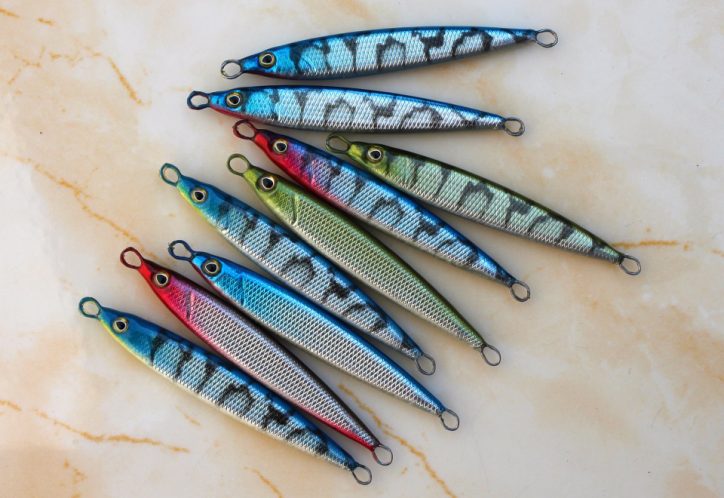
“Tjuljka” (“Sprat”) jig. 15 grams are available. Photo by © Sergey Rostetskiy.
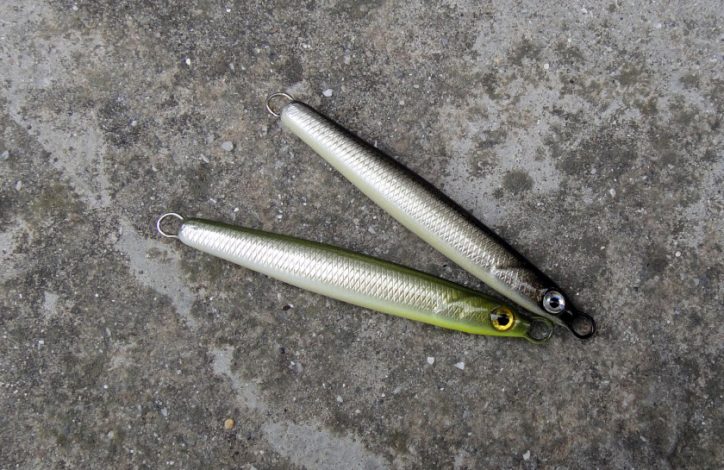
“Anchous” (“Anchovy”) jig. 12 grams are available. Photo by © Sergey Rostetskiy.

“Stavridka” (“Horse mackerel”) jig. 12, 18, 24 and 35 grams are available. Photo by © Sergey Rostetskiy.


“Daljnobojka” (“Long ranger”) jig. 24 и 33 grams are available. Photo by © Sergey Rostetskiy.
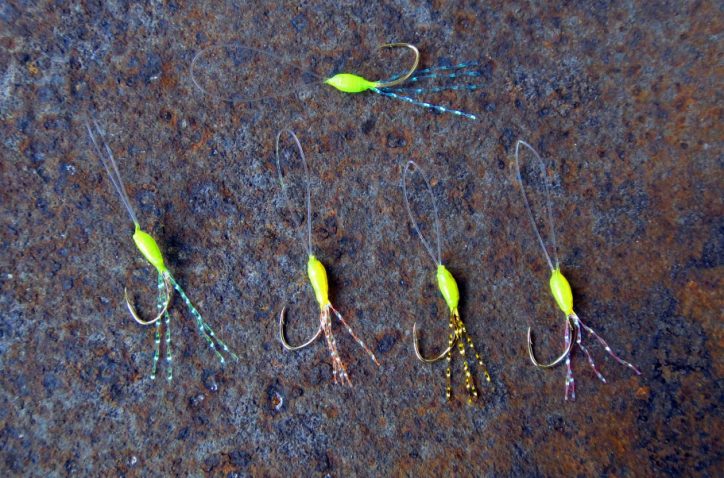
Sergey Rostetskiy’s handmade assist hooks. Photo by © Sergey Rostetskiy.
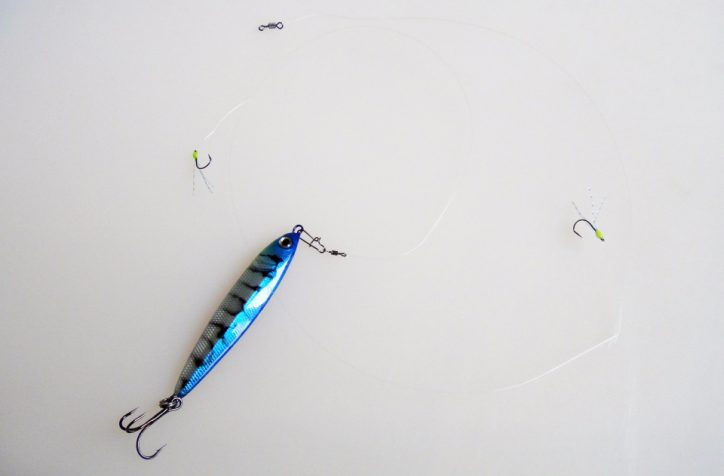
Sergey Rostetskiy’s handmade sabiki (with jig). Photo by © Sergey Rostetskiy.